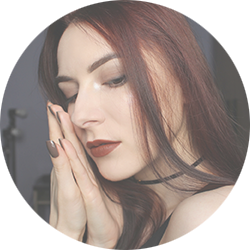







Welcome Back
Sign in to be closer to your community!
Follow other divas, like and comment
on their posts, message them, and see
who loved your posts!
Invalid username or password
You have not verified your account by clicking on the link we sent you via email. Please check your email folders (including your Spam folder) and click on the verify link sent.
Email is required
Password is required








Join FashionPotluck.com
Create your own profile in order to create content, follow other divas and like their posts, use our own messenger, and be a part of a growing international women community!
WELCOME TO OUR COMMUNITY
Fashion Potluck -
the first social media
platform for women.
You are free to read/watch & create content,
express your true self, and interact with others.
Join for free
Already a member? Log in here.
Purchase Alert
Dear Queen, you can only buy from one seller at the time. Please finish this purchase first in order to buy from another FP member
Comments
Please select one platform to continue
Please select one platform to continue
Please select one platform to continue
Please select one platform to continue
Please select one platform to continue
Please select one platform to continue
Please select one platform to continue
Please select one platform to continue
EDITOR APPROVED
You are wondering what is this 'Editor Approved'?
Well, this is pretty awesome! In order for the post to qualify and receive this accolade, it has to have a minimum of 700 words and two images (at least one original).
Receiving this accolade means two things: 1) Your content is amazing! Good job! 2) Your content qualifies for our monetization program. Every week two of the most read posts receive monetary rewards.
Have the badge & want to monetize your content?

LIFESTYLE



Hallucination is a word that most people associate with drug-use or psychotic disorder. However, the ability to distort and add to the information that we perceive as reality is a standard function of a healthy mind. If we’re to go by the definition above — taken from the Oxford English Dictionary — then we all hallucinate on a moment-to-moment basis.
In this article, we’re going to explore the different ways in which your eyes can tell you lies. Then, we’re going to take a look at how you can start to see past the more limiting illusions.
Sleepy fantasies
Let’s ease in with something not-so-shocking. Perhaps the most obvious type of convincing fantasy that we experience is dream imagery.
Take a moment to recall one of your dreams. Looking back, you know that dream environment was not your actual reality. It was a construct of sights, sounds, feelings and other sensations, compiled from a stockpile of memories in your mind. But did that space not seem entirely real while you were “in” it?
Our dreams feel real because there’s very little difference between the type of information we process while asleep and while awake. To the observing part of your consciousness, the unicorn you dreamt of last night was just as tangible as the boss you had a meeting with this morning. It’s what you decided about those experiences afterwards that set them apart.
What the brain adds
In his fascinating book on perception, The User Illusion, Tor Nørretranders asserts that 90% of what we perceive is internally generated. This means that the vast majority of what we see, hear, feel, taste and smell is fabricated in much the same way that our dream imagery is. The mind adds extra information to the raw data received by our sensory organs. And because this happens just before conscious recognition, it all seems entirely real.

You may have heard of the “blind spot” in human vision. This is a great example of the brain’s ability to create convincing imagery in lieu of actual information.
There’s a sheet of photoreceptors covering the retina at the back of the eye. This functions like the photosensitive film at the back of an old-school camera. It records the information transmitted via rays of light from the outside world.
However, at the point where the optic nerve attaches to the retina, there’s a hole in this sheet. What this means is that the brain can receive no information about that particular part of the picture. As a result, we have two blind spots: one for each eye.
But we don’t experience gaps in our vision and there are two reasons for this. Firstly, the blind spots in each eye are in different places so one eye sees what the other does not. Handy. However, even if you close one eye, you still don’t have a big black hole in your sight. This is because your brain is anticipating what it thinks should be seen in the blind spot based on what surrounds it. It then uses its estimation to plug the gap. That part of your vision is nothing more than a guess, and it’s not an insignificant size. Imagine a full moon in the night’s sky. Your blind spot could delete a moon ten times as big as that.
To actually see the blind spot being filled in, you can use the diagram below.
Instructions: Cover your left eye with your hand and focus on the cross with your right eye. Now, slowly move your head closer and farther away from the screen. There will be a point — probably around four inches on a desktop, much closer on a phone— at which the invisible man disappears. Don’t look directly at him, just keep looking at the cross and he’ll pop in and out of your peripheral vision as you move.

More than just pictures
The brain adds more than just simple imagery to our everyday experience. Let’s take a look at a familiar optical illusion.
This is called the Necker Cube. With this image, we’re presented with two different options. We either see a cube with its front panel in the bottom left corner of the picture. Or, we see one with its front panel in the top right. You can alternate between the two different cubes but you can’t see both at the same time.
The important point here is that neither is true. Of course, we’re not looking at a cube at all. It’s just an arrangement of lines. But although you know this to be the case, it’s very hard to look at the illusion without being aware of one of those imaginary shapes.
This means is that the brain has added extra information and presented us with something that is greater than the sum of its parts. We look at straight, flat lines but we perceive a 3D object.
With the Necker diagram, the illusion is obvious. But with the information our brains add to what we perceive around us, the fabrications can be much more convincing. So convincing, in fact, that we may not ever really be able to tell the difference between fantasy and reality.
Knowing the real
In 1781, Kant argued that there are two worlds:
- The “nouminal world,” which is the real, objective world.
- The “phenomenal world,” which is our version of the nouminal world as perceived by our individual minds.
Here’s what Steven Lehar has to say about this in The World in Your Head: A Gestalt View of the Mechanism of Conscious Experience.
“The only way we can perceive the nouminal world is by its effects on the phenomenal world. Therefore, the world we experience as external to our bodies is not actually the world itself, but only an internal virtual reality replica of that world generated by perceptual processes within our head.”
So, what we are seeing at any one time is not objective reality. Rather, it’s our own idiosyncratic version of reality. It’s embellished, much like the cube that we see when we observe the Necker diagram.
And, just as that cube is perceived as a result of our prior experience with cubes, the phenomenal world is also affected by what we have experienced in the past. It’s based almost entirely on what we already know (or think we know) to be true.

Take this next illusion. As Nørretranders points out, this diagram “shows that we are living on a planet that orbits a star!”.
The shapes in this image clearly appear as dimples or pimples depending on whether the “shadow” is at the top or the bottom.
But there are no shadows in this image. These are just 2D circles filled with a gradient. Yet, having lived its life on a planet that receives light from the sun (i.e. from above), the brain interprets the gradient as a shadow and converts the circles into 3D protrusions and indentations respectively. It does this because that’s what it’s used to seeing.
The question is, then, what else are we so used to seeing that we’ll project it into our environment and call it real?
The role of identity and self-image
The lens through which we view the world is based on more than just our beliefs about external things like sunlight and three-dimensions. We take our preconceptions everywhere we go. And the ones that can create the biggest illusions, almost certainly, are those that concern our sense of self.
I once had a friend who believed so strongly that she was unattractive that whenever someone gave her a compliment she would snap back angrily. Because of her negative self-image, she was convinced that they must be playing with her. And so, just like the straight, flat lines of the Necker Cube, she found it very hard to perceive the raw information (the compliment) for what it was. Instead, she added a third dimension of falsity and sarcasm.
But we don’t only add negative information to what we see. A guy once gave me a knowing wink when he caught me looking at him. He was clearly pleased to register the admiration on my face. But things got awkward just moments later when I made my real intentions known. The extra dimension this confident bartender had added to my straight lines was lusty desire. All I actually wanted from him was a beer. Cringe.
Hallucination as an acquired skill
Everyday hallucination isn’t something that just happens to us. It’s a skill, learned by the brain as we grow up to help us make (rapid) sense of reality and ease our existence in the world.

Children’s imaginary friends are a classic example of this. In response to some kind of lack in the child’s life — company, love, protection, excitement, etc. — the child’s mind hallucinates another being for them to play with. The fantasy fulfils an unmet need.
As adults (more commonly) we’re likely to daydream in order to satisfy our unmet needs. If we feel at a lack in terms of success, we might fantasise about winning the Nobel Prize or scoring the defining goal at the World Cup. Or, if the lack in our lives centres around an unmet need for love, we might daydream about finding the perfect partner and starting a picket-fence family life.
These fantasies are, of course, normal and entirely well-intentioned. But even though they’re designed to solve our needs-fulfilment issues, they rarely do. By obsessing over the perfect partner, we pile the pressure on and make dating really quite challenging. By daydreaming about Nobel Prizes rather than focusing on the work we’re actually doing, we make success less likely.
Often, the function of our fantasies is to sustain ongoing issues. Someone with anorexia, for example, may hallucinate their reflected self in the mirror as much larger than they really are (Body Dysmorphia). This visual distortion enables them to maintain their eating disorder. Again, this is well-intentioned. Their mind believes the anorexia to be solving problems. It’s just that it doesn’t. Not in reality.
But we all do this, don’t we? If not with our physical reflection, then with other things. We perceive challenges to be greater than they really are in order to justify our avoidance. We see spitefulness in the behaviour of others in order to explain our sense of victimhood. We see things like cake or alcohol as tastier than they really are in order to fuel our addictions…
What can we do about it?
So, how can we change our hallucinations? Is it possible to stop imagining things that confirm our deepest fears, sustain our problems or make us wink embarrassingly at people who were’t ever actually giving us the eye? Yes, it is. While it may not be possible to perceive the actual, unadulterated real world, we can work on minimising our distortions of it.
It requires that we become aware of what, exactly, it is that we’re likely to hallucinate. Obviously, this isn’t all that straightforward, but there are ways to question the fantasy. Here’s a simple exercise for you to try:
Taking another perspective
You’re going to imagine that you can step into someone else’s shoes for a moment to see through their belief-lens rather than yours.
Pick a good friend or a loving family member. Imagine that they’re sitting or standing in the room with you and observe them in detail. Then, walk over to their position and assume their role. Mimic their body language and facial expression as if you’re playing them in a film (the physical action here is important. If you just complete this process in your head, you’re likely to stick with your own lens rather than catch a glimpse through theirs).
Now, view yourself from this other person’s perspective and answer the questions below as if you were them:
For “X” read your own name.
- What do you love/value the most about X?
- What do you find the most impressive about X?
- What is X capable of but not currently realising?
- What do you believe about X that they do not?
- What does X believe about themselves that you do not?
So, what are the main differences between your self-image and the way you can see yourself from the other position?
This second perspective isn’t necessarily any more accurate than yours. But by recognising the discrepancies between the two, you can start to rupture the “reality” screen. The aim is to expose the glitches in your self-perception.
Spend a moment trying to hold the two versions in your mind at once. Uncomfortable, right? This is known as cognitive dissonance; the discomfort experienced by a person who holds two or more contradictory beliefs simultaneously. It’s like trying to see both cubes in the Necker diagram at one time.
Automatically, we fight cognitive dissonance by trying to prove one belief true and the other(s) false. You’ve likely already decided on your option, and you’re probably recalling “evidence” to back it up too. But neither of the perspectives you’re considering could ever possibly be the nouminal world truth. And the evidence your hallucinating right now is equally fabricated. It’s all just dream unicorns and imaginary shadows.
So, the question we should be asking isn’t about “truth” at all. Absolute truth is a thing that we can’t access, so it’s pointless (and painful) to try. What we should be asking ourselves instead is this:
Which version of “reality” would best serve me here?
Our beliefs, no matter what it might feel like, are choices that we have made. And they change. So, you can continue to believe painful things about yourself if you like. And if you do, you’ll continue to hallucinate looks of disapproval on the faces of your friends and colleagues, or disproportionate refections in the mirror…
Or, you could make a commitment now to start challenging your limiting perspectives and seeing the world through a different lens more often. Why not choose to believe that you can get the job when you walk into the interview? Why not opt to see the world as a place that loves, values and respects you, rather than one in which you have to fight for your survival?
Your mind is a learning machine. Given enough prompts, it’ll reassess its opinions. Your self-image, your memories, your beliefs… all these things are ever-evolving. To get them evolving in the direction you’d like is just a matter of mindful awareness and a little elbow grease.
So, the next time you see something that you don’t want to see, pause for a moment. It’s just one of a thousand options. The solution to your problem may be visible from a different angle. The problem itself may be invisible from another… And you, my friend, can take your pick of perspective. That’s what we’re all doing all the time anyway.
Originally published here.
Fight: Win Freedom From Self-sabotage
A book on the psychology of self-sabotage and how to take control.
Comments
Related Posts
- The Evolution of Women's Fashion: Key Historical Eras and Styles by Chloe Williamson 0
- 9 Things No One Tells You About Invisalign, But You’ll Wish You Knew Sooner by Monica Quinn 0
- Keep Diabetes in Check: 6 Fiber Superfoods You Should Eat by Monica Quinn 0
More Posts
- Why Cowboy Ties Are Making a Bold Fashion Comeback This Year by Rocky Mountain Western 0
- Havva Fashion – Trendy Women’s Wear for Every Occasion by 0
- Abiti da Sposa 2026: Eleganza Moderna, Tradizione Italiana e Tendenze da Non Perdere by Angelo Sonnino 0
Vote content out
Reason for voting this content out?
Reason for voting this content out?


 Login with Google
Login with Google Login with Twitter
Login with Twitter






 by
by
Add Comments